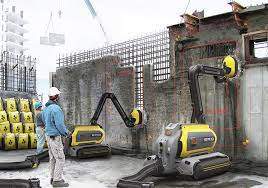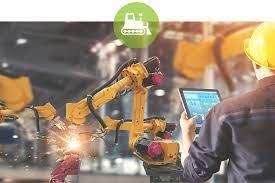Automation and robotics is the new trend in many different industries, as companies look for ways to automate repetitive, dangerous and time-consuming tasks to boost efficiency and improve worker safety.
The construction industry is no different, in fact, automation is an excellent solution for builders to increase operational efficiency and reduce costs.
The scope of automation in the construction industry is also very wide, extending from the initial planning stages to the commissioning and maintenance of the final structure.
Below are five examples of automation being used in the construction industry.

Autonomous machines on the construction site
Perhaps the most common example of automation in construction is the use of autonomous machines, these are essentially self-driving machines that can be used to move materials across a job site
and pulling heavy objects without endangering workers.
For example, machines can be equipped with robotic technology solutions and sensors that enable forklifts, excavators and trucks
and other similar equipment to operate without a driver in the cabin.
By creating related routes, providing GPS capabilities, and programming movement for the machine itself, construction site workers can operate machinery remotely and enjoy more efficient operations.
Drones to survey work areas and employees
Drones are another useful example of construction automation, allowing automated monitoring of job sites without the need for active supervision.
The use of drones allows construction companies to conduct pre-project inspections and other critical site monitoring activities.
Drones can be programmed to automatically scan a work area for potential hazards, after which the signals can be sent back to a central control system.

Robots in concrete work
Automation in construction has also found its way into concrete mixing,
where control systems and robots are used to mix concrete.
Cement laying, floor polishing, and surface water removal.
This also allows companies to create ready-made precast concrete products that take a much shorter time to install.
Automation also reduces material consumption and eliminates human error that would otherwise occur in concrete work.
Another area of concrete work that enjoys the benefits of automation is concrete floor polishing.
Programmable machines are used to polish soft concrete in commercial and residential buildings.
These machines can be programmed to pour and level concrete into the
correct portions while avoiding obstructions near the work area.
Demolition robots are also used to demolish walls and dismantle concrete slabs,
as this often results in lower operating costs and a safer working environment for employees.
IoT sensors for data collection and processing
Sensors are the main devices that make automation possible.
These devices can take real-time readings of location, temperature, pressure, and other conditions.
The sensors allow construction companies to automate many different machines
and robots according to their preferences.
Sensors can also send signals to machines to trigger an action.
For example, automation is typically achieved in welding and
manufacturing machines through the use of sensors.
These sensors collect important environmental data that can be used to trigger a relevant action in the welding machine.

Virtual reality during project planning and training
Virtual reality systems are another example of automation in construction,
as these systems allow construction companies to plan a project even before they lay a single brick.
Virtual reality simulates a realistic environment that allows builders to interact with a specific structure using a series of scanned images.
For example, builders can physically crawl through pipes in a building to
determine if they have enough room for repair and maintenance.
Virtual reality is an important form of automation because it uses programmed,
high-resolution 3D scans that are not susceptible to human error.
For more architectural news
The problem of temporary furnishing and solutions using flexible and renewable materials


 العربية
العربية